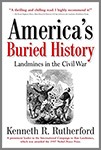New — AMERICA’S BURIED HISTORY by Kenneth R. Rutherford (Mauritania)
Despite the thousands of books published on the American Civil War, one aspect that has never received the in-depth attention it deserves is the use of landmines and their effect on the war and beyond. Kenneth R. Rutherford rectifies this oversight with America’s Buried History: Landmines in the Civil War, the first book devoted to a comprehensive analysis and history of the fascinating and important topic of landmines.
Modern mechanically fused high explosive and victim-activated landmines were used for the first time in the world’s history on a widespread basis in the American Civil War. The first American to die from a victim-activated landmine was on the Virginia peninsula in early 1862 during the siege of Yorktown. The controversial weapon, which was concealed on or beneath the ground, was built for one purpose: to kill or maim enemy troops. The weapon was the brainchild of Confederate General Gabriel J. Rains, who had experimented with explosive booby traps in Florida two decades earlier during the Seminole Wars. By the end of the war in 1865, some 2,000 “Rains mines” had been built and deployed in the field around Richmond. Simultaneously, other Confederate officers and soldiers also developed a sundry of landmine varieties, including command controlled and victim activated, across the Confederacy.
The Confederacy abandoned common practices in favor of innovative approaches that would help them overcome the significant deficits in materiel and manpower. The South’s reliance on these weapons pushed the limits of nineteenth century technology against a backdrop of a deteriorating military situation, setting off explosive debates inside the Confederate government and within the ranks of the army over the ethics of using “weapons that wait.” As the Confederacy’s fortune dissipated, its military leaders sought creative ways to fight, including leveraging low-cost weapons with minimal material inputs. This became an important factor in the increased support and attention landmines received from Confederate leaders. As the Civil War progressed, Southern military men continued to develop landmines with technological ingenuity adapted to local circumstances. Confederate soldiers manufactured landmines and also configured spur-of-the-moment landmines in a relatively ad hoc manner, often recycling unexploded Union ammunition. These debates over the ethics of mine warfare did not end in 1865.
Dr. Rutherford, who is known worldwide for his decades of work in the landmine discipline, brings together primary and other research from archives, museums, and battlefields to demonstrate that the Civil War was the first military conflict in world history to see the widespread use of such weapons. His study contributes to the literature on one of the most fundamental, contentious, and significant modern conventional weapons. According to careful estimates, by the early 1990s, landmines were responsible for more than 26,000 deaths each year worldwide.
America’s Buried History traces the development of landmines from their first use before the Civil War, to the early use of naval mines, through the establishment of the Confederacy’s Army Torpedo Bureau, the world’s first institution devoted to developing, producing, and fielding mines in warfare. As Dr. Rutherford demonstrates, landmines transitioned from “tools of cowards” and “offenses against democracy and civilized warfare” to an accepted form of warfare.
 Rutherford began his international career as a Peace Corps Volunteer in Mauritania (1987–1989). During this period he was contracted by the United Nations High Commissioner for Refugees to assist in refugee camps on the border between Mauritania and Senegal.
Rutherford began his international career as a Peace Corps Volunteer in Mauritania (1987–1989). During this period he was contracted by the United Nations High Commissioner for Refugees to assist in refugee camps on the border between Mauritania and Senegal.
He returned to the US to earn his MBA at the University of Colorado, then in 1993 went to work for the International Rescue Committee in Kenya and Somalia, where he was injured by a landmine.
Together with Jerry White he co-founded Landmine Survivors Network in 1995 which later became Survivor Corps. He and White accompanied Princess Diana on her last humanitarian mission to visit landmine survivors in Bosnia-Herzegovina in August 1997, only three weeks before her death. Rutherford was a prominent leader in the International Campaign to Ban Landmines which won the 1997 Nobel Peace Prize. In 2000, he earned his doctorate in Political Science from Georgetown University.
•
 America’s Buried History: Landmines in the Civil War
America’s Buried History: Landmines in the Civil War
by Kenneth R. Rutherford (Mauritania 1987-89)
Savas Beatie Publisher
216 pages
April 2020
$17.95 (Kindle) $29.95 (Hardback)
I had my own experience with land mines in Morocco in early 1962. From the Naval boot camp outside Chicago I was sent to my first duty station, McGuire Air Force Base in New Jersey where I trained as a Flight Traffic Specialist for Navy Squadron VR3. Flight Traffic Specialists, or F.T.S’s. as we were called, were the lowest rung on the flight crew’s ladder. The job entailed watching over passengers in flight and/or planning the placement of cargo loads to ensure plane safety on takeoffs and landings. It was a great job and since we flew mostly in support of UN initiatives, we’d often end up landing in some off the beaten path places.
On one of those flights we landed at Rabat in Morocco. Since we were going to be on the ground for a day or two most of the crew was released for 24 hours. My usual routine when this happened was to find a bus station and purchase a ticket to the end of the line for that route. Once there I’d set off walking down dusty roads knowing I could easily get back to the bus stop and from there to my C-188 aircraft in plenty of time. In this way I was able to really get a feel for the countries and meet rural types who were the backbone of the local culture. Most of my fellow crew members ended up in bars and thus cheated themselves out of the experiences I had.
On that day I finally found myself wandering along a sandy road with wood and wire fencing on both sides which at intervals sported signs in what I assumed was Arabic. The last words ended with double exclamation points. Beyond the fences were fields of quite lovely wildflowers where many butterflies flitted about. I soon was intrigued by one with beautiful colors and at least an eight inch wingspan. He was to my right and as I approached, flew across the road and over the left fence.
I uncapped my camera, scaled the fence and went after the butterfly. I was about forty or so feet into the flowers when a jeep pulled up on the sandy road and two military types began hollering at me and waving me back to the road. I complied and soon learned I’d been chasing my beautiful butterfly through a leftover WWII minefield which had never been cleared!
Dumb luck saved me and I was able to wander roads all over the world for two years as a Navy flight crew member. I never again jumped another fence however and sometimes wonder if those mine fields in Morocco were ever cleared.